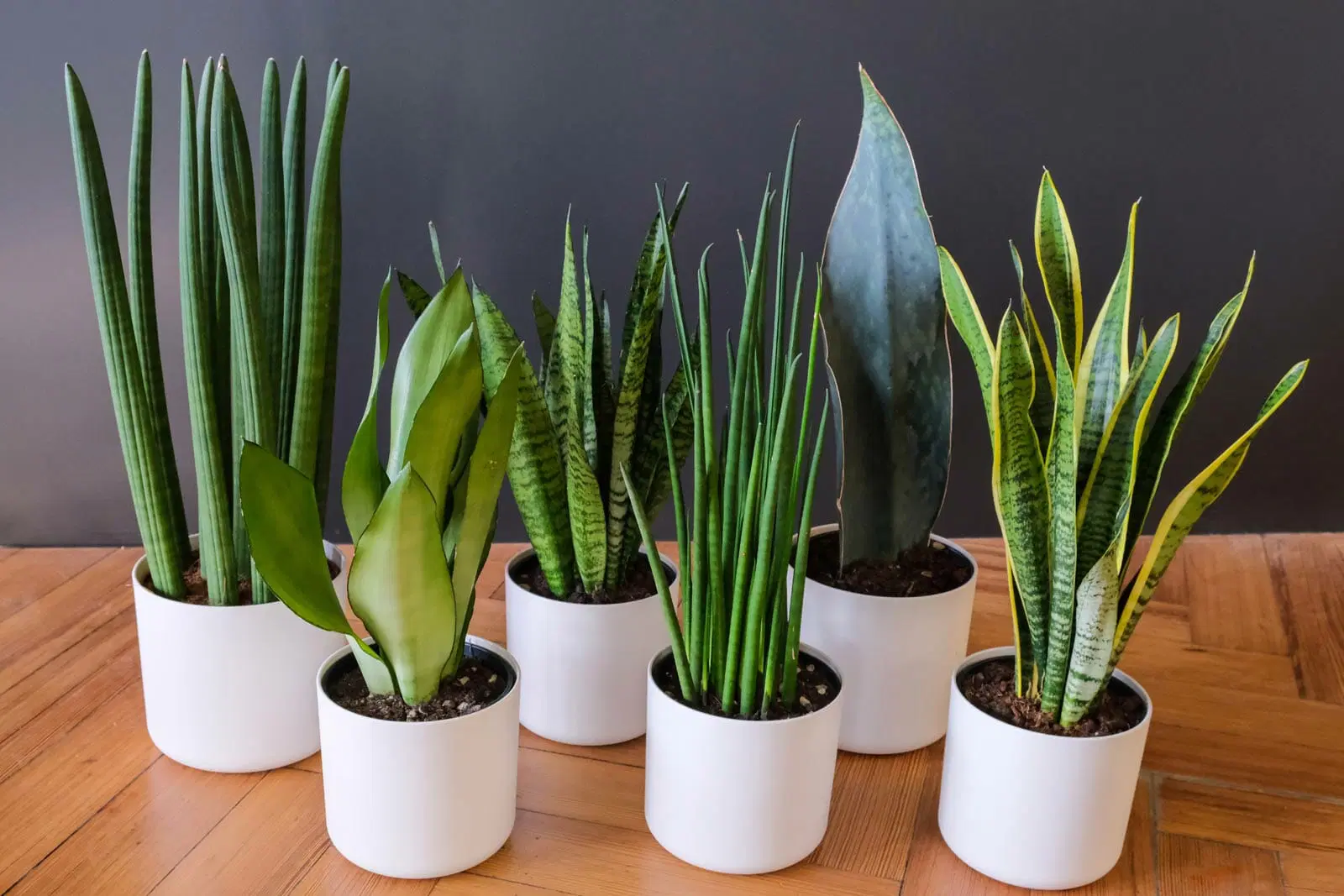Snake plants, also known as Sansevieria or Dracaena trifasciata, are some of the easiest and most versatile houseplants to grow. Their upright, sword-like leaves and resilience make them a popular choice for both novice and experienced gardeners. This detailed guide will walk you through everything you need to know about snake plants, from care tips to propagation techniques and even how to get them to bloom.
Snake Plant Care
Caring for snake plants is straightforward, making them ideal for people with busy schedules. Here are the essential care requirements:
1. Light Requirements
Snake plants thrive in a wide range of lighting conditions. Ideally, they prefer bright, indirect sunlight, but they can also tolerate low-light areas. Direct sunlight may scorch their leaves, so avoid placing them in harsh sunlight for extended periods.
2. Watering Needs
Snake plants are drought-tolerant and prefer infrequent watering. Allow the soil to dry completely between waterings to prevent root rot. As a general rule:
- Water every 2-6 weeks, depending on the season and humidity.
- In winter, reduce watering as the plant enters dormancy.
3. Temperature and Humidity
Snake plants prefer temperatures between 60°F and 85°F (15°C to 29°C). They are not frost-tolerant, so protect them from cold drafts and freezing temperatures. They adapt well to average indoor humidity levels, making them perfect for most homes.
4. Soil and Fertilizer
Use a well-draining potting mix, such as one designed for cacti and succulents. Fertilize sparingly during the growing season (spring and summer) with a balanced houseplant fertilizer diluted to half strength.
Snake Plant Varieties
There are several types of snake plants, each with unique leaf shapes, colors, and patterns. Here are some popular varieties:
1. Sansevieria Trifasciata ‘Laurentii’
This classic variety features tall green leaves with yellow edges. It’s one of the most recognizable types.
2. Sansevieria Cylindrica
Known as the cylindrical snake plant, this variety has round, tubular leaves that grow in a fan shape or can be braided for a unique look.
3. Sansevieria Moonshine
With its pale, silvery-green leaves, this variety has a striking, modern appearance.
4. Sansevieria Trifasciata ‘Golden Hahnii’
This dwarf variety is compact, with leaves that form a rosette pattern. It’s perfect for small spaces.
5. Sansevieria Zeylanica
This type has long, dark green leaves with subtle light green stripes, offering a more understated look.
How to Propagate a Snake Plant
Snake plants are easy to propagate, allowing you to create new plants from a single mother plant. Here are three popular methods:
1. Division
This is the quickest and most reliable method:
- Remove the plant from its pot.
- Gently separate the root ball into sections, ensuring each section has healthy roots and leaves.
- Plant the divisions in separate pots with fresh soil.
2. Leaf Cuttings
Leaf cuttings are a simple way to propagate:
- Cut a healthy leaf into 4-6 inch sections.
- Let the cuttings dry for a day or two to prevent rot.
- Plant the cuttings in soil, ensuring the correct end is facing down.
- Water sparingly until roots develop.
3. Water Propagation
This method is visually appealing:
- Place a leaf cutting in a glass of water, ensuring the bottom end is submerged.
- Change the water weekly to prevent stagnation.
- Once roots form, transfer the cutting to soil.
Pruning
Snake plants don’t require much pruning, but occasional maintenance keeps them healthy and attractive.
1. When to Prune
Prune when leaves become yellow, damaged, or overgrown. Late spring or early summer is ideal for major pruning.
2. How to Prune
- Use clean, sharp scissors or pruners.
- Cut leaves at the base, close to the soil.
- Remove dead or damaged leaves first, then trim for shape if necessary.
Potting and Repotting Snake Plant
Snake plants are slow growers, but they will eventually outgrow their pots. Repotting ensures healthy root growth.
1. When to Repot
Repot every 2-3 years or when roots start to push through the soil or pot.
2. How to Repot
- Choose a pot that is 1-2 inches larger in diameter than the current one.
- Use a well-draining soil mix.
- Carefully remove the plant, loosen the roots, and place it in the new pot.
- Fill the pot with soil, leaving about an inch of space at the top.
- Water lightly.
How to Get Snake Plant to Bloom
Although snake plants rarely bloom indoors, it’s possible with the right conditions.
1. Conditions for Blooming
- Provide bright, indirect light.
- Avoid overwatering.
- Allow the plant to become slightly root-bound.
2. Bloom Characteristics
Snake plant flowers are small, white, and fragrant. They grow on tall stalks and often appear unexpectedly.
Overwintering
Overwintering snake plants indoors is crucial for their survival in colder climates. Here’s a more detailed approach:
1. Adjust Watering Schedule
- During winter, the plant’s growth slows significantly. Overwatering during this period is a common cause of root rot.
- Water the plant only when the soil is completely dry, typically every 4-6 weeks.
2. Temperature and Placement
- Keep your snake plant in a room where the temperature stays above 50°F (10°C).
- Avoid placing it near cold drafts, windows, or heating vents, as sudden temperature changes can stress the plant.
3. Light Availability
- If natural light is limited during winter, consider using a grow light to supplement. Snake plants need some light to maintain their health even when dormant.
Common Pests
Although snake plants are resilient, they can occasionally attract pests. Here’s a detailed look at the most common issues:
1. Spider Mites
- Symptoms: Fine webbing and tiny specks on the leaves.
- Prevention and Solution:
- Increase humidity by misting the plant.
- Wipe leaves with a damp cloth or spray them with insecticidal soap.
2. Mealybugs
- Symptoms: White, cotton-like patches on leaves and stems.
- Prevention and Solution:
- Inspect new plants before introducing them to your collection.
- Dab affected areas with a cotton swab soaked in rubbing alcohol.
3. Scale Insects
- Symptoms: Hard, shell-like bumps on leaves.
- Prevention and Solution:
- Scrape off the scales gently with a soft brush or cloth.
- Apply neem oil or insecticidal soap to prevent further infestations.
4. Fungus Gnats
- Symptoms: Small black flies around the soil surface.
- Prevention and Solution:
- Allow the soil to dry out between waterings.
- Use sticky traps or a soil drench with diluted hydrogen peroxide.
Common Problems With Snake Plants
Snake plants are hardy, but improper care can lead to issues. Here’s how to troubleshoot common problems:
1. Yellowing Leaves
- Cause: Overwatering is the primary culprit.
- Solution: Let the soil dry out completely before watering again and ensure the pot has proper drainage.
2. Brown Leaf Tips
- Cause: Inconsistent watering or low humidity.
- Solution: Water evenly and maintain a stable environment.
3. Mushy or Rotting Leaves
- Cause: Root rot due to excessive moisture.
- Solution: Remove the plant from the pot, trim rotted roots, and repot in fresh, dry soil.
4. Curling Leaves
- Cause: Pests, under-watering, or temperature extremes.
- Solution: Inspect for pests, water regularly, and avoid exposure to extreme temperatures.
Benefits of Snake Plants
Snake plants offer far more than just aesthetic appeal. They provide a host of benefits, making them a valuable addition to any home or office. Here’s an in-depth look at their advantages:
1. Air Purification
Snake plants are natural air purifiers. According to a NASA Clean Air Study, they can remove toxins such as formaldehyde, benzene, and trichloroethylene from the air. These chemicals are often found in common household items, and having snake plants can significantly improve indoor air quality.
2. Oxygen Production
Unlike most plants, snake plants perform a type of photosynthesis known as CAM (Crassulacean Acid Metabolism). This means they release oxygen at night, making them ideal for bedrooms as they can improve air quality while you sleep.
3. Low Maintenance
Snake plants are among the easiest houseplants to care for. They thrive on neglect, requiring minimal watering and light, making them perfect for people with busy lifestyles or limited gardening experience.
4. Boosting Humidity
While snake plants don’t require high humidity, they release moisture into the air, contributing to a more comfortable environment, especially in dry indoor spaces.
5. Stress Reduction and Productivity
Studies have shown that having plants indoors can reduce stress, boost mood, and increase productivity. Snake plants, with their simple care requirements and clean look, are perfect for workspaces and living areas.
6. Allergy Relief
By removing airborne allergens and releasing oxygen, snake plants can help alleviate symptoms for people with allergies. They trap dust and pollutants, making the air cleaner and healthier to breathe.
7. Feng Shui and Energy
In Feng Shui, snake plants are considered good for positive energy. Their upward growth symbolizes progress, and placing them in the right spot can attract good fortune and ward off negative energy.
FAQ
Here are answers to some frequently asked questions about snake plants:
1. How often should I water my snake plant?
Water your snake plant every 2-6 weeks, depending on the season and humidity levels. Always let the soil dry completely before watering.
2. Can snake plants grow in low light?
Yes, snake plants can tolerate low light conditions, though they grow best in bright, indirect sunlight.
3. Why are my snake plant’s leaves turning yellow?
Yellowing leaves are usually a sign of overwatering. Let the soil dry out and ensure the pot has adequate drainage.
4. Can I propagate a snake plant in water?
Yes, you can propagate a snake plant in water by placing a leaf cutting in a glass of water. Once roots form, transfer it to soil.
5. Do snake plants need fertilizer?
Snake plants don’t require frequent fertilization. Feed them with a diluted houseplant fertilizer during the growing season (spring and summer) for best results.
6. Are snake plants toxic to pets?
Yes, snake plants are mildly toxic to pets if ingested, causing symptoms like nausea or vomiting. Keep them out of reach of cats and dogs.
7. How do I get my snake plant to flower?
Snake plants may flower if they are slightly root-bound, kept in bright light, and watered sparingly. Their flowers are fragrant and typically appear on tall stalks.
Read Next: https://techcrunchs.net/how-to-grow-rhododendrons-a-comprehensive-guide/









